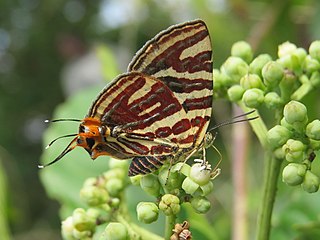
Lethe europa, the bamboo treebrown, is a species of Satyrinae butterfly found in Asia.

Hippotion celerio, the vine hawk-moth or silver-striped hawk-moth, is a moth of the family Sphingidae. It was described by Carl Linnaeus in his 1758 10th edition of Systema Naturae.

Plusia festucae is a species of moth of the family Noctuidae. It is found throughout the Palearctic realm from Ireland to Japan.

Cigaritis lohita, the long-banded silverline, is a species of lycaenid or blue butterfly.
Sufetula cyanolepis is a moth in the family Crambidae. It was described by George Hampson in 1912. It is found in Indonesia (Sulawesi).
Ambia fulvicolor is a moth in the family Crambidae. It was described by George Hampson in 1917 and it is found in New Guinea.
Auzata ocellata is a moth in the family Drepanidae. It was described by Warren in 1896. It is found in northern India, northern Myanmar and Fujian in China.
Psittacastis argentata is a moth in the family Depressariidae. It was described by Edward Meyrick in 1921. It is found in Brazil.
Psittacastis cosmodoxa is a moth in the family Depressariidae. It was described by Edward Meyrick in 1921. It is found in Peru.
Psittacastis eumolybda is a moth in the family Depressariidae. It was described by Edward Meyrick in 1926. It is found in Peru.
Psittacastis gaulica is a moth in the family Depressariidae. It was described by Edward Meyrick in 1909. It is found in Bolivia.
Psittacastis molybdaspis is a moth in the family Depressariidae. It was described by Edward Meyrick in 1926. It is found in Peru.
Psittacastis pictrix is a moth in the family Depressariidae. It was described by Edward Meyrick in 1921. It is found in Colombia.
Psittacastis trierica is a moth in the family Depressariidae. It was described by Edward Meyrick in 1909. It is found in Bolivia.
Psittacastis championella is a moth in the family Depressariidae. It was described by Lord Walsingham in 1912. It is found in Guatemala.
Psittacastis incisa is a moth in the family Depressariidae. It was described by Lord Walsingham in 1912. It is found in Mexico (Tabasco) and Panama.
Psittacastis stigmaphylli is a moth in the family Depressariidae. It was described by Lord Walsingham in 1912. It is found on Jamaica.
Psittacastis cocae is a moth in the family Depressariidae. August Busck described it in 1931. It is found in Peru.
Psittacastis propriella is a moth in the family Depressariidae. It was described by Francis Walker in 1864. It is found in Brazil (Amazonas) and Guyana.
Pammenemima ochropa is a moth of the family Tortricidae first described by Edward Meyrick in 1905. It is found in Sri Lanka and its Barberyn Island.



